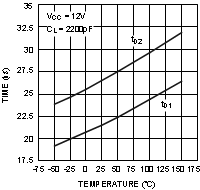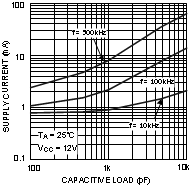SNVS234C September 2004 – September 2016 LM5112 , LM5112-Q1
PRODUCTION DATA.
- 1 Features
- 2 Applications
- 3 Description
- 4 Revision History
- 5 Pin Configuration and Functions
- 6 Specifications
- 7 Detailed Description
- 8 Application and Implementation
- 9 Power Supply Recommendations
- 10Layout
- 11Device and Documentation Support
- 12Mechanical, Packaging, and Orderable Information
Package Options
Refer to the PDF data sheet for device specific package drawings
Mechanical Data (Package|Pins)
- NGG|6
Thermal pad, mechanical data (Package|Pins)
Orderable Information
6 Specifications
6.1 Absolute Maximum Ratings
over operating free-air temperature range (unless otherwise noted)(1)(2)| MIN | MAX | UNIT | ||
|---|---|---|---|---|
| VCC to VEE | –0.3 | 15 | V | |
| VCC to IN_REF | –0.3 | 15 | V | |
| IN/INB to IN_REF | –0.3 | 15 | V | |
| IN_REF to VEE | –0.3 | 5 | V | |
| Maximum junction temperature | 150 | °C | ||
| Operating junction temperature | –40 | 125 | °C | |
| Storage temperature, Tstg | –55 | 150 | °C | |
(1) Stresses beyond those listed under Absolute Maximum Ratings may cause permanent damage to the device. These are stress ratings only, which do not imply functional operation of the device at these or any other conditions beyond those indicated under Recommended Operating Conditions. Exposure to absolute-maximum-rated conditions for extended periods may affect device reliability.
(2) If Military/Aerospace specified devices are required, please contact the Texas Instruments Sales Office/ Distributors for availability and specifications.
6.2 ESD Ratings
| VALUE | UNIT | |||
|---|---|---|---|---|
| V(ESD) | Electrostatic discharge | Human-body model (HBM), per ANSI/ESDA/JEDEC JS-001(1) | ±2000 | V |
(1) JEDEC document JEP155 states that 500-V HBM allows safe manufacturing with a standard ESD control process.
6.3 Recommended Operating Conditions
over operating free-air temperature range (unless otherwise noted)| MIN | MAX | UNIT | |||
|---|---|---|---|---|---|
| VCC | Operating voltage, VCC – IN_REF and VCC – VEE | 3.5 | 14 | V | |
| Operating junction temperature | –40 | 125 | °C | ||
6.4 Thermal Information
| THERMAL METRIC(1) | LM5112, LM5112-Q1 | UNIT | ||
|---|---|---|---|---|
| NGG (WSON) | DGN (MSOP PowerPAD) | |||
| 6 PINS | 8 PINS | |||
| RθJA | Junction-to-ambient thermal resistance | 40 | 53.7 | °C/W |
| RθJC(top) | Junction-to-case (top) thermal resistance | 50.8 | 61.1 | °C/W |
| RθJB | Junction-to-board thermal resistance | 29.3 | 37.2 | °C/W |
| ψJT | Junction-to-top characterization parameter | 0.7 | 7.2 | °C/W |
| ψJB | Junction-to-board characterization parameter | 29.5 | 36.9 | °C/W |
| RθJC(bot) | Junction-to-case (bottom) thermal resistance | 7.5 | 4.7 | °C/W |
(1) For more information about traditional and new thermal metrics, see the Semiconductor and IC Package Thermal Metrics application report.
6.5 Electrical Characteristics
TJ = –40°C to 125°C, VCC = 12 V, INB = IN_REF = VEE = 0 V, and no Load on output (unless otherwise noted).| PARAMETER | CONDITIONS | MIN | TYP | MAX | UNIT | |
|---|---|---|---|---|---|---|
| SUPPLY | ||||||
| VCC | Operating voltage | VCC – IN_REF and VCC – VEE | 3.5 | 14 | V | |
| UVLO | Undervoltage lockout (rising) | VCC – IN_REF | 2.4 | 3 | 3.5 | V |
| VCCH | Undervoltage hysteresis | 230 | mV | |||
| ICC | Supply current | 1 | 2 | mA | ||
| CONTROL INPUTS | ||||||
| VIH | Logic high | 2.3 | V | |||
| VIL | Logic low | 0.8 | V | |||
| VthH | High threshold | 1.3 | 1.75 | 2.3 | V | |
| VthL | Low threshold | 0.8 | 1.35 | 2 | V | |
| HYS | Input hysteresis | 400 | mV | |||
| IIL | Input current low | IN = INB = 0 V | –1 | 0.1 | 1 | µA |
| IIH | Input current high | IN = INB = VCC | –1 | 0.1 | 1 | µA |
| OUTPUT DRIVER | ||||||
| ROH | Output resistance high | IOUT = –10 mA(1) | 30 | 50 | Ω | |
| ROL | Output resistance low | IOUT = 10 mA(1) | 1.4 | 2.5 | Ω | |
| ISOURCE | Peak source current | OUT = VCC / 2,200 ns pulsed current | 3 | A | ||
| ISINK | Peak sink current | OUT = VCC / 2,200 ns pulsed current | 7 | A | ||
| LATCHUP PROTECTION | ||||||
| AEC–Q100, METHOD 004 | TJ = 150°C | 500 | mA | |||
(1) The output resistance specification applies to the MOS device only. The total output current capability is the sum of the MOS and bipolar devices.
6.6 Switching Characteristics
over operating free-air temperature range (unless otherwise noted)| PARAMETER | TEST CONDITIONS | MIN | TYP | MAX | UNIT | |
|---|---|---|---|---|---|---|
| td1 | Propagation delay time low to high, IN or INB rising (IN to OUT) |
CLOAD = 2 nF, see Figure 13 | 25 | 40 | ns | |
| td2 | Propagation delay time high to low, IN or INB falling (IN to OUT) |
CLOAD = 2 nF, see Figure 13 | 25 | 40 | ns | |
| tr | Rise time | CLOAD = 2 nF, see Figure 13 | 14 | ns | ||
| tf | Fall time | CLOAD = 2 nF, see Figure 13 | 12 | ns | ||
6.7 Typical Characteristics
 Figure 1. Supply Current vs Frequency
Figure 1. Supply Current vs Frequency
 Figure 3. Rise and Fall Time vs Supply Voltage
Figure 3. Rise and Fall Time vs Supply Voltage
 Figure 5. Rise and Fall Time vs Capacitive Load
Figure 5. Rise and Fall Time vs Capacitive Load
 Figure 7. Delay Time vs Temperature
Figure 7. Delay Time vs Temperature
 Figure 9. UVLO Thresholds and Hysteresis vs Temperature
Figure 9. UVLO Thresholds and Hysteresis vs Temperature
 Figure 2. Supply Current vs Capacitive Load
Figure 2. Supply Current vs Capacitive Load
 Figure 4. Rise and Fall Time vs Temperature
Figure 4. Rise and Fall Time vs Temperature
 Figure 6. Delay Time vs Supply Voltage
Figure 6. Delay Time vs Supply Voltage
 Figure 8. Rds(on) vs Supply Voltage
Figure 8. Rds(on) vs Supply Voltage
 Figure 10. Peak Current vs Supply Voltage
Figure 10. Peak Current vs Supply Voltage